Mid-August 2013, blue sky over the Aischgrund in Franconia. Kai Wagner and Josef Engelhart meet at the "Golden Cross", the inn in the small village of Ickelheim with its two striking gatehouses. The meeting place is well chosen, and not only because of the home-made platter that the two of them are eating, because it is accompanied by the "Hausschoppen", a hearty white wine from a stone jug. It is homemade and comes from the oldest pile vineyard in Germany, the Ickelheimer Schlossberg. Sadly, its days are numbered, because the Heinlein family can no longer do the painstaking manual work for health reasons, and a successor has not been found. The vineyard has not been tended for months, and so the last stone jugs are now being served and emptied. Then it will be over.
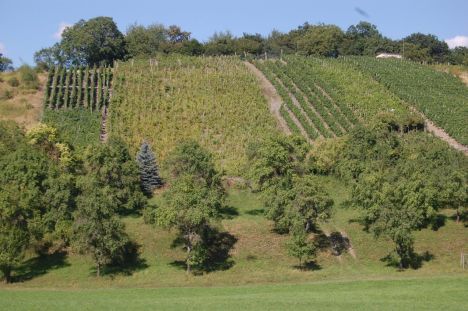 |
| The Ickelheimer Schlossberg: small parcels% closely planted% not cleaned up. Here there are several old pieces% planted in the Gemischter Satz. (Photo: K. Wagner) |
The purpose of the meeting between Wagner and Engelhart, the viticultural technician and sought-after grape variety expert from the Bavarian State Institute for Viticulture and Horticulture in Veitshöchheim, is not to empty as many jugs as possible, but to take a closer look at the old vineyards near Ickelheim. For they are exciting and unique for several reasons. The old vineyards there are not only naturally low in yield and therefore produce extract-rich, expressive wines, they are above all planted in the Gemischter Satz, the once common method of guarding against the perils of weather and disease. Many different grape varieties are planted in a vineyard in a criss-cross pattern, harvested at one time, made into a must and into a wine. And that is supposed to taste good? The scepticism is not unjustified, because the right care and, above all, optimal ripeness can only be ensured if only one grape variety is cultivated. But here, too, the rule is: the proof of the pudding is in the eating.
Which grape varieties come together in the Gemischter Satz depends entirely on the circumstances; sometimes there are only a few, sometimes more than 30 different varieties, sometimes one variety dominates, sometimes the ratio is more balanced. Two things, however, are typical for the old vineyards in the mixed set: one finds grape varieties there that are uncommon, even unknown today. And: The vines are ungrafted. The old vineyards are thus becoming a precious pool of grape varieties and genes, which is becoming increasingly important in the face of resource depletion and climate change. The most experienced German grape variety researcher, Andreas Jung, makes it clear: "Old grape varieties can only be found in old vineyards in Germany. The most valuable vineyards are those that were planted before the Second World War and are still ungrafted planted. These mostly still contain the varieties cherished by the grandfathers in their original clonal diversity. They are the last refuges for culturally and historically important traditional grape varieties and a treasure trove of site-tested clonal diversity."
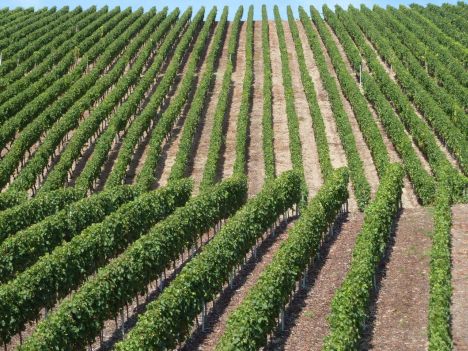 |
| This is how vineyards in Franconia usually look today, as here near Escherndorf: machine-accessible and large-scale. (Photo: K. Wagner) |
The few remaining old vineyards that have survived countless frost nights, phylloxera, land consolidation and conversion to building land are small, usually only a few hundred square metres in size, densely planted and therefore laborious and only cultivable by hand. They are scattered all over Franconia, mostly outside the wine-growing centres, and are often kept alive not by professional winegrowers but by enthusiasts. For example, for the past two years Peter Vogel has been tending a vineyard planted in 1901 on the Kehlberg in Rottendorf, the only vineyard where the forgotten Putzscheere was found, a late-ripening grape variety from the Pannonian region that was quite common after the 17th century. Recreational winemaker Hartmut Scheuring has a tiny plot of ancient vines and partly historic grape varieties such as the Blue Tokay in the magnificent but little-known, steep terraced site of Steinbacher Nonnnenberg. The yield is often only a little more than 100 bottles. Herbert Schneider produces the light and delicately fruity "Anno Domini" from the old vines that grow in a small enclosed plot on the stone staircase that leads from Wipfeld's market square up to the church.
The small village of Ickelheim, which was already founded in the time of Charlemagne, has a small vineyard, the "Schlossberg", which has not been cleared of vines. It is divided into many bits and pieces, many of which are old and valuable. In addition to the Heinlein family's Pfahlweinberg, the 100-year-old plot managed by the agile, almost 80-year-old Mrs. Eitel is a treasure trove of old vines. The aromatic and pure-toned wine is vinified and distributed by the Meier winery in Ulsenheim. One thing is clear to Wagner and Engelhart on this sunny August day in Ickelheim: the few remaining old vineyards should be preserved. And that only works if they are farmed and the wine they produce can be sold well. Sounds like a case for the "Slow Food Ark of Taste": drink what you want to save. It's a good thing that the Mainfranken-Hohenlohe Convivium has long had the "Fränkischer Gemischter Satz" on its radar as an Ark candidate. Something has to happen soon: a meeting of the winegrowers and a big tasting of the wines from the Gemischter Satz.
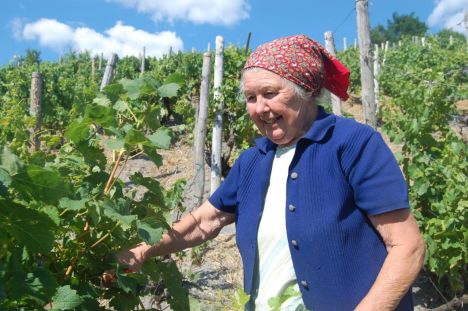 |
| Often it is older people% who tend the few remaining vineyards. Mrs. Eitel is 80 years old and works the vineyard at Schlossberg% the wine is made and sold by Markus Meier in Ulsenheim. (Photo: K. Wagner) |
It is good that there are also a few full-time winegrowers who have dedicated themselves to the preservation of old vineyards and the Gemischter Satz. The oldest vineyard, planted in 1835 with over 30 grape varieties, among which Elbling is by far the dominant variety, is hidden in the middle of a cornfield two kilometres north of the village of Rimbach. It is successfully and professionally cultivated by the Zang winery from Sommerach. The top Franconian winemakers from Zehnthof in Sulzfeld, Wolfgang, Philipp and Uli Luckert, decided a few years ago to save two tiny parcels of land in the middle of their hometown with ancient vines planted in 1870 and 1920. The plot with vines from 1870 is planted with Blue and Yellow Silvaner, the other with the classic Franconian Gemischter Satz. Both were nurtured and brought into yield. Even the first wine, punchy, complex, finely woven and deep, from the Silvaner vineyard that was literally rescued at the last minute from its final disappearance, impressively shows the potential of the old vineyards.
The fact that there are plots with old plantings in the Gemischter Satz even in world-famous top sites is amazing and a special stroke of luck. In the Klingenberger Schlossberg, terraced with a good 200 kilometres of dry stone walls, where some of Germany's best red wines grow, Wolfgang Kühn owns the "Altrod", planted more than 80 years ago, where the red varieties Portugieser, St. Laurent and Pinot Noir predominate. The eponymous wine is finely fruity, animating and blossoms after a few years of bottle maturity. Also at the Klingenberg Schlossberg, tour guide Gabriele Stahl-Euteneuer has planted a museum vineyard together with the Stritzinger organic winery, also dominated by red varieties, which yields the powerful "Vinum Franconium Purpureum". There are also some old vineyards on the northern edge of the Franconian wine-growing region: in Zell am Ebersberg, where Peter Götz and Nico Scholtens have vineyards that are a good 100 years old with a variety of long-forgotten grape varieties, or in Ramsthal, where Kellers produce the "Ur-Ramsthaler", and in Machtilshausen, where a strong, spicy "Altfränkisch" thrives from the steep "Sommerleite", which is vinified by the Theilheim organic winegrower Edgar Wallrapp.
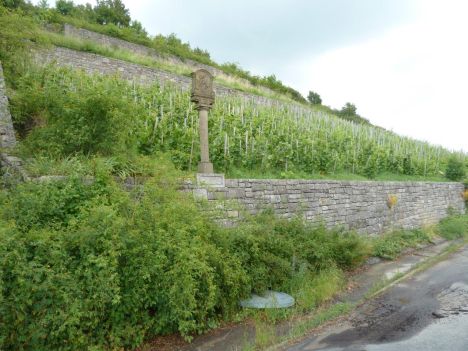 |
| The museum vineyard near Randersacker - this Altfränkisch Wengert was planted by Armin Störrlein. (Photo: K. Wagner) |
More and more winegrowers are realising that the Gemischter Satz is not only a centrepiece of wine culture, but also an exciting and challenging cultivation variant that produces completely unusual, lively and varied aroma profiles. Thus, the VDP estates Bickel-Stumpf, Roth, Schlör and others have planted new versions of Gemischter Satz that are simply delicious. Particularly praiseworthy is the initiative by VDP winemaker Armin Störrlein, who has planted the "Altfränkischer Wengert" in the Randersackerer "Pfülben" in the classic Franconian style, where all the work is done as it was in the days of the forefathers. The result is a deep, highly refined wine, characterised by the grape variety mix of Riesling, Traminer, Silvaner, Gutedel, Muskateller, Ruländer, Elbling, Spätburgunder, Trollinger, Portugieser as well as the rare Bukettrebe.
Half a year later, the time has come. On 8 February 2014, it rains in Würzburg. Engelhart, Wagner and Gerd Sych, spokesman for the Slow Food Convivium Mainfranken-Hohenlohe, meet in the Greising-Saal to make final preparations for an event that has it all and is a real premiere: almost all Franconian winegrowers who cultivate old vineyards that produce wines in the Gemischter Satz are meeting for the first time. They have brought their wines with them, because following the exchange of ideas between the vintners, the public tasting starts, which has been booked out for a long time. The arche-candidate "Fränkischer Gemischter Satz" takes off, the foundation of a working group "Old Vineyards - Old Satz" is decided, the Ickelheim Pfahlweinberg is to be put into good hands.
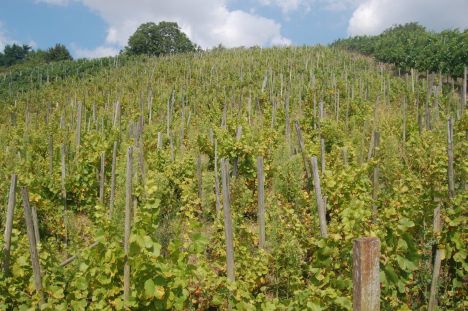 |
| The Heinlein family's Pfahlweinberg in Ickelheim in August 2013: about 20 different% mostly old grape varieties% true to their roots% but not cultivated for months. It was to be abandoned - that was the initial spark of the rescue project for the Alten Satz. (Photo: K. Wagner) |
Those who still have doubts about the potential of the Gemischter Satz, despite the great reception the Würzburg event has received among winegrowers and wine lovers, should take a look at Austria. There, too, the Gemischter Satz has survived, especially in the wine-growing region of Vienna, and the enterprising winemaker Fritz Wieninger, together with almost twenty colleagues, has created the "Wiener Gemischter Satz" presidium. Today, "Wiener Gemischter Satz" is not only an EU-protected designation, but a wine sought after worldwide, popular even in Manhattan, as Wieninger proudly proclaims on his website. It would be a laugh if the Franconians couldn't do the same.
All currently tasted Franconian wines from several grape varieties